The global feed mixer for livestock market is valued at USD 646.3 million in 2025 and is set to reach USD 877 million by 2035, recording an absolute increase of USD 230.7 million over the forecast period. This translates into a total growth of 35.7%, with the market forecast to expand at a compound annual growth rate (CAGR) of 3.1% between 2025 and 2035. The overall market size is expected to grow by approximately 1.4X during the same period, supported by increasing livestock farming operations, growing demand for efficient feed distribution systems, and rising requirements for nutritional consistency across dairy, beef, and mixed farming operations.
The global feed mixer for livestock market represents a critical segment within the agricultural equipment and animal husbandry industry, driven by the need for uniform feed distribution and the operational efficiency benefits of mechanized mixing systems. These specialized machines blend various feed ingredients including hay, silage, grains, and nutritional supplements to create consistent total mixed rations (TMR) for livestock populations. Feed mixers operate through mechanical mixing actions, providing thorough ingredient integration and reliable distribution capabilities for various herd sizes and farm configurations. The mixing mechanism enables proper nutrient distribution across feed batches, making these devices particularly suitable for commercial dairy operations, beef feedlots, and mixed livestock facilities requiring precise nutritional management.
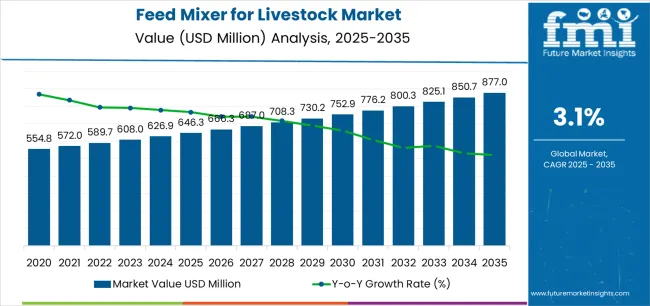
The market encompasses various mixer configurations, capacity ratings, and specialized designs tailored for specific livestock farming applications. Modern feed mixers incorporate advanced auger systems, improved mixing chamber designs, and enhanced discharge mechanisms that can withstand demanding agricultural environments while maintaining consistent performance over extended operational periods. The integration of digital monitoring systems, weight measurement capabilities, and programmable mixing sequences has further enhanced the value proposition of these mixer systems among farm operators seeking operational efficiency and feed conversion optimization.
Market dynamics are significantly influenced by agricultural productivity requirements, particularly in commercial dairy and beef production where feed consistency and nutritional accuracy are paramount for animal health and production outcomes. The farming sector's increasing emphasis on mechanization, labor efficiency, and herd nutrition management has created substantial demand for high-performance feed mixer solutions in livestock operations, feeding facilities, and agricultural service providers. Additionally, the growing trend toward larger herd sizes and precision livestock farming has amplified the need for reliable mixer systems capable of handling diverse feed formulations and supporting data-driven feeding protocols.
Consumer purchasing patterns show a marked preference for mixer systems that combine durable construction with versatile capacity options, multiple power configurations, and comprehensive service support for diverse livestock farming applications. The market has witnessed significant technological advancement in mixing auger design, load cell integration, and discharge control systems, making these devices more suitable for various feed ingredients, multiple livestock species, and demanding agricultural environments.
Between 2025 and 2030, the feed mixer for livestock market is projected to expand from USD 646.3 million to USD 752.9 million, resulting in a value increase of USD 106.6 million, which represents 46.2% of the total forecast growth for the decade. This phase of development will be shaped by increasing commercial livestock farming adoption, rising demand for mechanized feed distribution solutions, and growing availability of precision mixing systems across dairy operations and beef production facilities.
Between 2030 and 2035, the market is forecast to grow from USD 752.9 million to USD 877 million, adding another USD 124.1 million, which constitutes 53.8% of the overall ten-year expansion. This period is expected to be characterized by the advancement of sensor-enabled feed monitoring systems, the development of variable capacity mixing platforms for diverse farm operations, and the expansion of automated feed distribution networks across commercial livestock facilities. The growing emphasis on feed conversion efficiency and nutritional consistency will drive demand for advanced feed mixer varieties with enhanced mixing uniformity, improved ingredient handling characteristics, and superior operational monitoring performance profiles.
Between 2020 and 2024, the feed mixer for livestock market experienced steady growth, driven by increasing agricultural mechanization investments and growing recognition of total mixed ration benefits in livestock production following extensive farm productivity campaigns. The market developed as farm operators recognized the advantages of mechanized feed mixing over manual distribution methods in commercial operations and began seeking specialized solutions designed for precise nutritional management requirements. Technological advancement in auger design and weighing technologies began emphasizing the critical importance of maintaining mixing consistency while enhancing operational efficiency and improving feed conversion rates across diverse livestock farming applications.
| Metric | Value |
|---|---|
| Estimated Value in (2025E) | USD 646.3 million |
| Forecast Value in (2035F) | USD 877 million |
| Forecast CAGR (2025 to 2035) | 3.1% |
From 2030 to 2035, the market is forecast to grow from USD 752.9 million to USD 877 million, adding another USD 124.1 million, which constitutes 53.8% of the overall ten-year expansion. This period is expected to be characterized by the advancement of precision feeding technology integration in mixer monitoring systems, the integration of predictive load management for optimal mixing cycles, and the development of specialized mixer configurations for varied livestock production applications. The growing emphasis on feed efficiency and herd nutrition management will drive demand for premium varieties with enhanced mixing performance capabilities, improved capacity flexibility options, and superior automated operation characteristics.
Between 2020 and 2024, the feed mixer for livestock market experienced robust growth, driven by increasing awareness of feed-related production costs and growing recognition of specialized mixer systems' effectiveness in supporting profitable livestock operations across dairy farms and beef production facilities. The market developed as users recognized the potential for feed mixers to deliver operational advantages while meeting modern requirements for consistent feed distribution and reliable mechanical performance. Technological advancement in mixing chamber optimization and ingredient handling development began emphasizing the critical importance of maintaining mixing thoroughness while extending operational life and improving user satisfaction across diverse agricultural mixer applications.
Market expansion is being supported by the increasing global emphasis on livestock farming efficiency and the corresponding shift toward mechanized feed distribution systems that can provide superior mixing uniformity while meeting user requirements for consistent animal nutrition and cost-effective operation solutions. Modern farm operators are increasingly focused on incorporating mixer systems that can enhance herd performance while satisfying demands for uniform, properly distributed feed rations and optimized labor utilization practices. Feed mixers' proven ability to deliver mechanical mixing excellence, nutritional consistency benefits, and diverse application possibilities makes them essential equipment for productivity-focused livestock farmers and quality-focused agricultural professionals.
The growing emphasis on herd nutrition optimization and agricultural equipment reliability is driving demand for high-performance feed mixer systems that can support distinctive production outcomes and comprehensive nutritional management across dairy operations, beef feeding applications, and commercial livestock installations. User preference for mixer solutions that combine functional excellence with capacity versatility is creating opportunities for innovative implementations in both traditional and emerging livestock farming applications. The rising influence of precision agriculture technologies and advanced herd management systems is also contributing to increased adoption of automated feed mixer solutions that can provide authentic operational benefits and reliable performance tracking characteristics.
The market is segmented by type, application, capacity, mixing technology, and region. By type, the market is divided into pull-type, stationary, and other mixer configurations. Based on application, the market is categorized into dairy cattle farms, beef cattle farms, sheep farms, mixed livestock operations, and others. By capacity, the market includes small capacity, medium capacity, and large capacity categories. By mixing technology, the market encompasses vertical auger, horizontal auger, and paddle mixer configurations. Regionally, the market is divided into North America, Europe, Asia Pacific, Latin America, Middle East & Africa, and other regions.
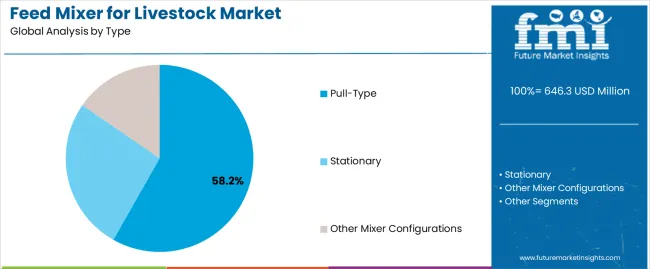
The pull-type segment is projected to account for 58.2% of the feed mixer for livestock market in 2025, reaffirming its position as the leading type category. Farm operators and livestock producers increasingly utilize pull-type systems for their superior mobility characteristics, established versatility standards, and essential functionality in diverse feeding operations across multiple farm layouts. Pull-type mixers' proven performance characteristics and established cost-effectiveness directly address user requirements for flexible feed distribution and optimal operational mobility in dairy and beef production applications.
This type segment forms the foundation of modern livestock feeding performance patterns, as it represents the mixer configuration with the greatest operational versatility and established compatibility across multiple farm management systems. Agricultural investments in advanced mobility technology and performance optimization continue to strengthen adoption among productivity-focused users. With farmers prioritizing operational flexibility and distribution efficiency, pull-type systems align with both labor objectives and performance requirements, making them the central component of comprehensive livestock nutrition strategies.
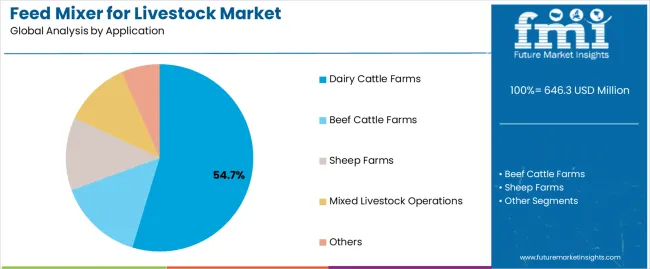
Dairy cattle farms is projected to represent 54.7% of the feed mixer for livestock market in 2025, underscoring its critical role as the primary application for nutrition-focused users seeking superior mixing benefits and enhanced herd production management credentials. Dairy operators and farm managers prefer dairy applications for their established nutritional requirements, proven production demand, and ability to maintain exceptional feed consistency while supporting comprehensive herd coverage during daily feeding activities. Positioned as essential applications for efficiency-focused dairy producers, dairy offerings provide both production excellence and nutrition optimization advantages.
The segment is supported by continuous improvement in dairy farming technology and the widespread availability of established nutritional protocols that enable performance assurance and premium positioning at the farm level. Additionally, dairy operators are optimizing mixer selections to support ration-specific applications and comprehensive herd nutrition strategies. As precision dairy farming continues to advance and producers seek efficient feeding methods, dairy applications will continue to drive market growth while supporting production efficiency and nutrition optimization strategies.
The feed mixer for livestock market is advancing rapidly due to increasing farm mechanization adoption and growing need for consistent feed distribution solutions that emphasize superior mixing uniformity across dairy segments and beef production applications. However, the market faces challenges, including competition from manual feeding methods, equipment maintenance considerations, and initial capital cost factors affecting adoption rates. Innovation in mixing efficiency enhancement and advanced ingredient handling continues to influence market development and expansion patterns.
The growing adoption of feed mixers with load cell integration and data recording connectivity is enabling users to develop nutrition strategies that provide distinctive monitoring benefits while commanding automated operation and enhanced real-time ration analysis characteristics. Precision farming applications provide superior nutritional consistency while allowing more sophisticated feed management features across various livestock categories. Users are increasingly recognizing the operational advantages of intelligent mixer positioning for comprehensive nutrition outcomes and technology-integrated herd management.
Modern feed mixer manufacturers are incorporating advanced load cell sensors, real-time ingredient tracking capabilities, and recipe storage systems to enhance mixing precision, improve ration accuracy effectiveness, and meet agricultural demands for consistent livestock feeding solutions. These systems improve operational effectiveness while enabling new applications, including automated ration adjustment programs and ingredient inventory protocols. Advanced weighing integration also allows users to support data-driven feeding positioning and performance assurance beyond traditional mixer operation requirements.
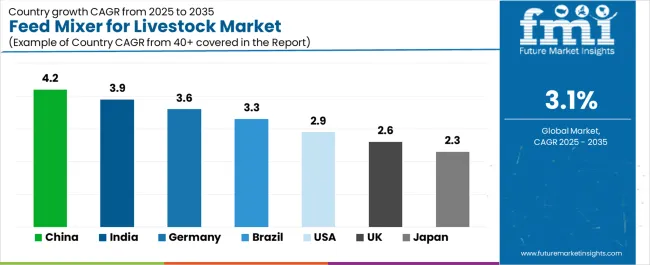
| Country | CAGR (2025-2035) |
|---|---|
| China | 4.2% |
| India | 3.9% |
| Germany | 3.6% |
| Brazil | 3.3% |
| USA | 2.9% |
| UK | 2.6% |
| Japan | 2.3% |
The feed mixer for livestock market is experiencing robust growth globally, with China leading at a 4.2% CAGR through 2035, driven by the expanding commercial livestock sector, growing farm mechanization requirements, and increasing adoption of modern feeding systems. India follows at 3.9%, supported by rising dairy production intensity, expanding cattle farming operations, and growing acceptance of mechanized equipment. Germany shows growth at 3.6%, emphasizing established agricultural standards and comprehensive dairy farming development. Brazil records 3.3%, focusing on beef production expansion and agricultural efficiency growth. The USA demonstrates 2.9% growth, prioritizing advanced farming technologies and feed conversion optimization.
The report covers an in-depth analysis of 40+ countries, top-performing countries are highlighted below.
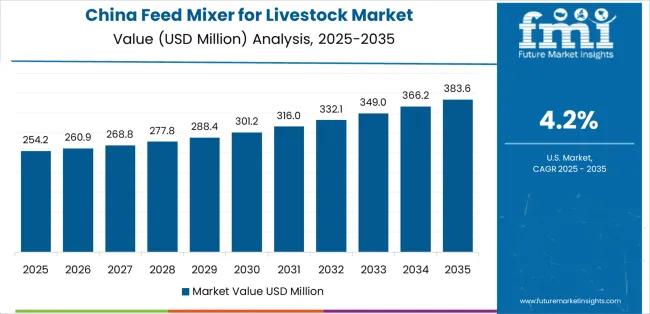
Revenue from feed mixer for livestock consumption and sales in China is projected to exhibit exceptional growth with a CAGR of 4.2% through 2035, driven by the country's rapidly expanding commercial dairy sector, favorable government policies toward agricultural modernization, and initiatives promoting mechanization technologies across major livestock regions. China's position as a growing livestock production hub and increasing focus on feed efficiency systems are creating substantial demand for high-quality feed mixers in both domestic and export markets. Major agricultural equipment companies and farm machinery distributors are establishing comprehensive mixer capabilities to serve growing demand and emerging mechanization opportunities.
Revenue from feed mixer for livestock products in India is expanding at a CAGR of 3.9%, supported by rising dairy production investment, growing mechanization consciousness, and expanding agricultural distributor capabilities. The country's developing livestock infrastructure and increasing investment in farming technologies are driving demand for feed mixers across both traditional and modern dairy applications. International equipment companies and domestic distributors are establishing comprehensive operational networks to address growing market demand for feed distribution devices and efficient farming solutions.
Revenue from feed mixer for livestock products in Germany is projected to grow at a CAGR of 3.6% through 2035, supported by the country's mature agricultural standards, established farm mechanization regulations, and leadership in dairy production technology. Germany's sophisticated farming standards and strong support for advanced livestock systems are creating steady demand for both traditional and innovative feed mixer varieties. Leading agricultural manufacturers and specialty distributors are establishing comprehensive operational strategies to serve both domestic markets and growing export opportunities.
Revenue from feed mixer for livestock products in Brazil is projected to grow at a CAGR of 3.3% through 2035, driven by the country's emphasis on beef production development, cattle farming modernization growth, and growing agricultural distributor capabilities. Brazilian farm operators and livestock facilities consistently seek mechanization-focused equipment that enhances feeding efficiency and supports production excellence for both traditional and modern cattle operations. The country's position as a Latin American beef leader continues to drive innovation in specialized feeding applications and agricultural equipment standards.
Revenue from feed mixer for livestock products in the USA is projected to grow at a CAGR of 2.9% through 2035, supported by the country's emphasis on agricultural technology advancement, livestock feeding optimization, and advanced herd management integration requiring efficient distribution solutions. American farm operators and dairy-focused facilities prioritize feed consistency and operational precision, making specialized feed mixers essential equipment for both traditional and modern livestock farming applications. The country's comprehensive agricultural technology leadership and advancing farming patterns support continued market expansion.
Revenue from feed mixer for livestock products in the UK is projected to grow at a CAGR of 2.6% through 2035, supported by established agricultural standards, mature dairy markets, and emphasis on operational reliability across livestock farming sectors. British farm operators and dairy professionals prioritize quality performance and feeding consistency, creating steady demand for dependable mixer solutions. The country's comprehensive market maturity and established farming practices support continued development in specialized applications.
Revenue from feed mixer for livestock products in Japan is projected to grow at a CAGR of 2.3% through 2035, supported by the country's emphasis on precision agriculture, operational excellence, and advanced technology integration requiring efficient feeding solutions. Japanese farm operators and dairy-focused facilities prioritize technical performance and production precision, making specialized feed mixers essential equipment for both traditional and modern livestock farming applications. The country's comprehensive agricultural leadership and advancing precision patterns support continued market expansion.
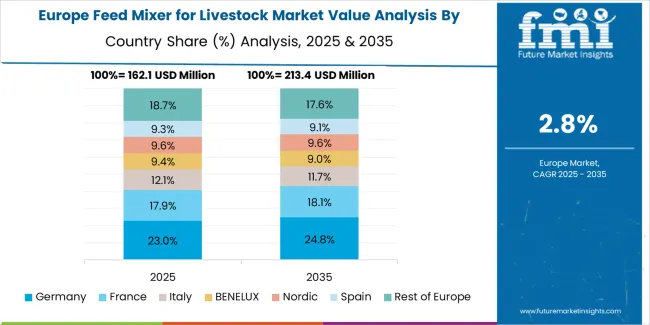
The Europe feed mixer for livestock market is projected to grow from USD 192.7 million in 2025 to USD 256.4 million by 2035, recording a CAGR of 2.9% over the forecast period. Germany leads the region with a 38.6% share in 2025, moderating slightly to 38.1% by 2035, supported by its strong dairy farming traditions and demand for premium, precision-engineered mixer solutions. France follows with 23.4% in 2025, rising to 24.1% by 2035, driven by extensive cattle farming operations and emphasis on agricultural mechanization advancement. The United Kingdom accounts for 14.9% in 2025, easing to 14.3% by 2035, reflecting a mature dairy sector and focus on operational reliability and quality performance.
Italy holds 9.7% in 2025, expanding to 10.4% by 2035 as livestock farming modernization and specialty feeding applications grow. Spain contributes 6.2% in 2025, growing to 6.6% by 2035, supported by expanding cattle development and mechanization awareness. The Nordic countries rise from 4.8% in 2025 to 5.1% by 2035 on the back of strong dairy consciousness and advanced farming methodologies. BENELUX remains at 2.4% share across both 2025 and 2035, reflecting mature, dairy-focused agricultural markets.
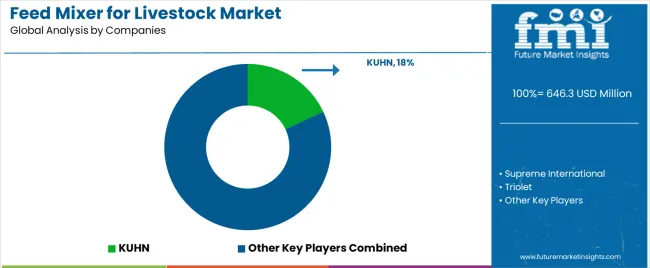
The feed mixer for livestock market is characterized by competition among established agricultural equipment manufacturers, specialized mixer companies, and integrated farm machinery providers. Companies are investing in advanced mixing technologies, specialized auger engineering, product innovation capabilities, and comprehensive dealer networks to deliver consistent, high-quality, and reliable feed mixer systems. Innovation in mixing chamber optimization, ingredient handling advancement, and agriculture-focused product development is central to strengthening market position and customer satisfaction.
KUHN leads the market with 18% share with a strong focus on agricultural technology innovation and comprehensive livestock feeding solutions, offering dairy and beef systems with emphasis on performance excellence and manufacturing heritage. Supreme International provides integrated mixer designs with a focus on commercial farm applications and precision distribution networks. Triolet delivers comprehensive feeding technology solutions with a focus on dairy positioning and operational efficiency. Highline Manufacturing specializes in vertical mixer systems with an emphasis on Canadian farming applications. Jaylor International focuses on comprehensive TMR solutions with advanced design and premium positioning capabilities.
The success of feed mixers for livestock in meeting agricultural productivity demands, farm efficiency requirements, and operational integration will not only enhance livestock production outcomes but also strengthen global agricultural equipment manufacturing capabilities. It will consolidate emerging regions' positions as hubs for efficient farm machinery production and align advanced economies with comprehensive mechanization systems. This calls for a concerted effort by all stakeholders -- governments, industry bodies, manufacturers, distributors, and investors. Each can be a crucial enabler in preparing the market for its next phase of growth.
How Governments Could Spur Local Production and Adoption?
How Industry Bodies Could Support Market Development?
How Distributors and Agricultural Equipment Players Could Strengthen the Ecosystem?
How Manufacturers Could Navigate the Shift?
| Items | Values |
|---|---|
| Quantitative Units (2025) | USD 646.3 million |
| Type | Pull-Type, Stationary, Other Mixer Configurations |
| Application | Dairy Cattle Farms, Beef Cattle Farms, Sheep Farms, Mixed Livestock Operations, Others |
| Capacity | Small Capacity, Medium Capacity, Large Capacity |
| Mixing Technology | Vertical Auger, Horizontal Auger, Paddle Mixer |
| Regions Covered | North America, Europe, Asia Pacific, Latin America, Middle East & Africa, Other Regions |
| Countries Covered | China, India, Germany, Brazil, United States, United Kingdom, Japan, and 40+ countries |
| Key Companies Profiled | KUHN, Supreme International, Triolet, Highline Manufacturing, Jaylor International, and other leading feed mixer for livestock companies |
| Additional Attributes | Dollar sales by type, application, capacity, mixing technology, and region; regional demand trends, competitive landscape, technological advancements in mixer engineering, feeding efficiency optimization initiatives, mechanization enhancement programs, and premium product development strategies |
The global feed mixer for livestock market is estimated to be valued at USD 646.3 million in 2025.
The market size for the feed mixer for livestock market is projected to reach USD 877.0 million by 2035.
The feed mixer for livestock market is expected to grow at a 3.1% CAGR between 2025 and 2035.
The key product types in feed mixer for livestock market are pull-type, stationary and other mixer configurations.
In terms of application, dairy cattle farms segment to command 54.7% share in the feed mixer for livestock market in 2025.






Full Research Suite comprises of:
Market outlook & trends analysis
Interviews & case studies
Strategic recommendations
Vendor profiles & capabilities analysis
5-year forecasts
8 regions and 60+ country-level data splits
Market segment data splits
12 months of continuous data updates
DELIVERED AS:
PDF EXCEL ONLINE
Feed Preparation Machine Market Size and Share Forecast Outlook 2025 to 2035
Feed Additive Nosiheptide Premix Market Size and Share Forecast Outlook 2025 to 2035
Feeder Container Market Size and Share Forecast Outlook 2025 to 2035
Feed Machine Market Forecast Outlook 2025 to 2035
Feed Pigment Market Forecast and Outlook 2025 to 2035
Feed Grade Spray-dried Animal Plasma (SDAP) Market Size and Share Forecast Outlook 2025 to 2035
Feed Electrolytes Market Size and Share Forecast Outlook 2025 to 2035
Feed Micronutrients Market Size and Share Forecast Outlook 2025 to 2035
Feed Acidifier Market Analysis Size Share and Forecast Outlook 2025 to 2035
Feed Flavors Market Size and Share Forecast Outlook 2025 to 2035
Feed Enzymes Market Analysis - Size, Share, and Forecast Outlook 2025 to 2035
Feed Mycotoxin Binders Market Size and Share Forecast Outlook 2025 to 2035
Feed Phytogenics Market Size and Share Forecast Outlook 2025 to 2035
Feed Carbohydrase Market Size and Share Forecast Outlook 2025 to 2035
Feed Grade Oils Market Analysis - Size, Share, and Forecast Outlook 2025 to 2035
Feed Packaging Market Size, Share & Forecast 2025 to 2035
Feed Mycotoxin Detoxifiers Market Analysis - Size, Share, and Forecast Outlook 2025 to 2035
Feed Premix Market Analysis - Size, Share, & Forecast Outlook 2025 to 2035
Feed Phytogenic Market Analysis - Size, Share, & Forecast Outlook 2025 to 2035
Feed Attractants Market Analysis by Composition, Functionality, Livestock, Packaging Type and Sales Channel Through 2035

Thank you!
You will receive an email from our Business Development Manager. Please be sure to check your SPAM/JUNK folder too.
Chat With
MaRIA